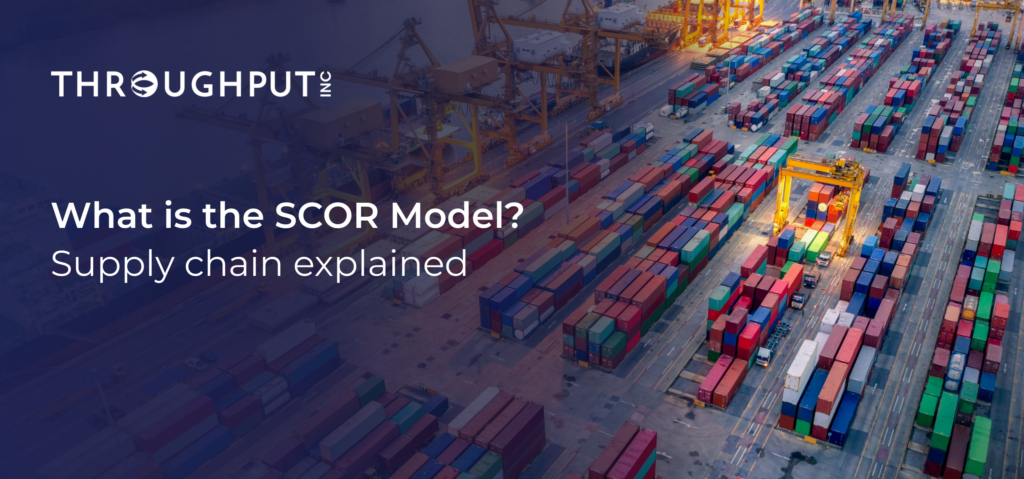What is the SCOR model? Supply chain management explained

The SCOR (Supply Chain Operations Reference) model is a performance-based framework for managing supply chain activities.
It provides a framework for evaluating and comparing supply chain activities, enabling organizations to identify areas for improvement and implement best practices.
Mastering the SCOR model is not just a theoretical exercise, but a practical tool that can be wielded by supply chain professionals navigating global trade and logistics networks.
Understanding and implementing this model can lead to tangible improvements in supply chain operations, empowering supply chain professionals with the knowledge and tools they need to excel in their roles.
This piece will teach you about the development of the SCOR model throughout history, including its essential components. We’ll also delve into the varied applications of the SCOR theory in different sectors, highlighting its impact on productivity.
Let’s look at how this influential theory was developed and recognize its prominent role in the supply chain industry.
The Genesis and Evolution of the SCOR Model
The SCOR model, a significant advancement in supply chain management, was introduced in 1996 by Pittiglio Rabin Todd & McGrath and AMR Research. This marked a pivotal moment in the industry, as it standardized operations and introduced a common language for professionals.
The model’s development was a response to the need for companies to optimize their supply chain activities, promoting better integration and operational excellence.
Over the years, the governance of the SCOR model transitioned. Initially, the Supply Chain Council oversaw it, and later, in 2014, APICS merged with the Supply Chain Council to form APICS SCC.
The SCOR model has not only evolved significantly but also demonstrated its adaptability. It incorporated the ENABLE process category in 2013 to recognize the role of supporting activities in supply chain management.
The latest version, released in 2017, updated maturity models, best practices, and terminology to address new challenges and technologies like omnichannel strategies, metadata, and blockchain.
The ongoing evolution of the SCOR model highlights its role as a foundational element in supply chain optimization. Its ability to adapt to new trends and technologies has preserved its relevance for businesses aiming to improve their supply chain operations, making it a pivotal tool in today’s fast-paced global market.
What’s the structure of the SCOR model?
The SCOR model is structured into four levels: level 1 (strategic), level 2 (tactical), level 3 (operational), and level 4 (detailed). Each process is further divided into activities, which are the specific tasks or actions needed to complete the process.
At level 1, the strategic level, the focus is on developing a high-level strategy for the supply chain. This involves defining the overall goals and objectives of the supply chain and identifying the key performance indicators (KPIs) that will be used to measure success. At this level, the emphasis is on understanding the market and customer requirements and developing a supply chain strategy aligned with these requirements.
Level 2, the tactical level, is where the strategic plan is translated into specific actions and initiatives. At this level, the focus is optimizing the supply chain network, balancing supply and demand, and managing and optimizing inventory levels. This involves developing a detailed plan for production, procurement, and distribution and ensuring that the supply chain is responsive to changes in demand.
Level 3, the operational level, is where the day-to-day activities of the supply chain are managed. This includes managing the flow of goods and information, monitoring and controlling inventory levels, and ensuring that orders are fulfilled on time and in full. At this level, the focus is on operational efficiency and effectiveness and meeting customer requirements.
Finally, at level 4, the detailed level, each process is broken down into specific activities or tasks required to complete it. This involves developing detailed procedures and work instructions and ensuring that these are followed consistently. The emphasis at this level is on continuous improvement and on identifying opportunities to streamline processes and eliminate waste.
What are the Components of the SCOR Model?
The components of the SCOR model are Plan, Source, Make, Deliver, Return, and Enable.
The SCOR model is distinguished by its comprehensive approach to supply chain management, which encompasses a range of processes crucial for effective operation.
The structure of the model is built around six core process categories, each addressing a specific area of supply chain functionality:
Plan
This process involves demand and supply planning, which includes balancing resources with requirements and establishing plans for the supply chain. It also encompasses the management of business rules, data collection, inventory, capital assets, transportation, and regulatory requirements.
Source
This category covers the sourcing of stocked, make-to-order, and engineer-to-order products. It includes scheduling deliveries, receiving and transferring products, authorizing supplier payments, and managing supplier performance and incoming inventory.
Make
This process focuses on production activities, including scheduling and managing production, testing, packaging, preparing for delivery, and releasing production orders.
Deliver
This involves order management, warehousing, transportation, and distribution activities. It includes everything from managing customer orders to transporting products to the final destination.
Return
This category addresses the return of products, whether due to defects, excess, or obsolescence, and includes return receipt, scheduling, and disposition.
Enable
This process supports the design and management of the planning and execution processes. It reflects the growing importance of activities that enable the core processes to function effectively, such as quality management, sales operations planning, and supply chain risk management.
In the next section, we will delve into the digital transformation of the SCOR model and how it addresses the needs of modern supply chains in a digital era.
What’s a Real-life Example of the SCOR Model?
The best real-life examples of the SCOR model are in companies like Infineon Technologies AG, Intel Corporation, and Alcatel-Lucent Enterprise.
These case studies demonstrate the SCOR model’s capacity to significantly improve supply chain operations by offering a structured approach and clear metrics for benchmarking and improvement.
Here’s a breakdown of each example:
Alcatel-Lucent Enterprise
Alcatel-Lucent Enterprise used the SCOR model in the telecommunications sector following the economic downturn in 2001 to enhance its supply chain operations. Applying SCOR metrics allowed Alcatel to effectively measure and benchmark its performance, contributing to a more resilient and competitive supply chain in a challenging economic environment.
Intel Corporation
Another notable case is Intel, a multinational corporation and technology leader. Intel’s adoption of the SCOR model facilitated improvements in various aspects of the supply chain, including inventory management and delivery operations. The company utilized SCOR metrics to measure and benchmark its performance, leading to a more streamlined and efficient supply chain.
Infineon Technologies AG
German semiconductor manufacturer Infineon embarked on an 18-month project using the SCOR model to build an agile and adaptable supply chain. This extensive project involved hundreds of employees, customers, suppliers, and production partners. The results were impressive, with marked supply chain flexibility and responsiveness improvements.
In the next section, we’ll explore the specific performance categories and metrics of the SCOR model and how they contribute to effective supply chain management.
How to measure SCOR Performance?
SCOR performance is measured with categories and attributes that provide a deep understanding of the supply chain’s strengths and areas for improvement.
These categories are:
Reliability
This category focuses on the dependability of the supply chain. Key performance attributes include on-time delivery, order fill, and accuracy rates. Reliability metrics ensure that supply chain operations consistently meet customer expectations.
Responsiveness
This area measures the speed at which the supply chain can fulfill customer demands. It includes metrics like order lead times or the speed of responding to customer orders.
Responsiveness is crucial in today’s fast-paced market, where customers expect quick and efficient service.
Agility
Agility refers to the supply chain’s ability to respond to unforeseen events or changes in market demand. This category includes response times for unexpected events and production flexibility.
A highly agile supply chain can adapt quickly, maintaining efficiency despite disruptions.
Cost
This performance category assesses the efficiency of supply chain operations in terms of cost. Metrics include supply chain management and logistics costs, cost of goods sold, and warranty and returns processing costs.
Effective cost management is essential for maintaining profitability and competitiveness.
Asset Management Efficiency
This area evaluates how effectively a company manages its assets within the supply chain. Key metrics include cash-to-cash cycle time, inventory days of supply, and asset turns. Efficient asset management ensures optimal resource use and minimizes unnecessary expenditures.
In the following section, we will explore how companies use SCOR-based benchmarking to set performance goals and develop competitive strategies in the supply chain.
What is Benchmarking and Performance Measurement in SCOR?
Benchmarking is a process that involves setting realistic performance goals, calculating performance gaps against a global database, and developing company-specific roadmaps for competitive success in the supply chain industry.
This process is facilitated by the SCOR model’s provision of a comprehensive set of performance metrics categorized according to five key performance attributes: reliability, responsiveness, agility, costs, and asset management efficiency.
These metrics allow organizations to measure their performance in a structured and standardized manner, enabling meaningful comparisons across different industries or supply chain configurations.
Here’s a breakdown of each step:
STEP 1: Setting Performance Goals
Companies can use the SCOR model to establish achievable and aspirational performance goals based on global best practices. This ensures that targets are challenging and grounded in realistic benchmarks, making them more meaningful and attainable.
STEP 2: Calculating Performance Gaps
Through SCOR-based benchmarking, companies can identify their position in relation to industry standards and leading competitors. This gap analysis is crucial for understanding areas of strength and pinpointing opportunities for improvement.
STEP 3: Developing Competitive Strategies
Armed with insights from SCOR benchmarking, companies can tailor their strategies to address specific areas of the supply chain that require enhancement. This could range from optimizing logistics and inventory management to improving supplier relationships and customer service.
In our next section, we’ll delve into the challenges companies face when implementing the SCOR model and explore how it is evolving to meet the future demands of supply chain management.
What are the Challenges of Implementing SCOR?
The challenges of implementing the SCOR model include adapting to industry changes and future directions.
These challenges, coupled with the evolving landscape of supply chain management, point towards future directions and adaptations of the model.
Implementation Challenges
One of the primary hurdles in implementing the SCOR model is the complexity of integrating it into existing supply chain operations.
The model requires significant time and open communications within the firm and among supply chain partners. This can be a daunting task for companies with established processes and systems.
Additionally, the SCOR model demands a comprehensive understanding of its framework and a commitment to continuous improvement, which can be resource-intensive.
Adapting to Industry Changes
The supply chain industry is constantly changing, influenced by globalization, technological advancements, and consumer demands.
These updates indicate a shift towards integrating digital strategies and sustainability standards into supply chain operations.
Future Directions
Looking ahead, the SCOR model is likely to embrace digital transformation and sustainability further.
As supply chains become more digitized and data-driven, the SCOR model must incorporate advanced supply chain analytics, artificial intelligence, and machine learning to enhance decision-making and efficiency.
Moreover, with increasing emphasis on sustainability and ethical supply chain practices, future iterations of the SCOR model are expected to integrate these aspects more deeply into its framework.
Conclusion
The SCOR model is valuable for organizations looking to improve their supply chain performance.
The model provides a comprehensive framework for managing supply chains, helping organizations identify inefficiencies, implement best practices, and measure their progress.
Implementing the SCOR model requires a commitment to continuous improvement, collaboration, and leveraging technology to support supply chain operations.
Organizations can successfully execute the SCOR model and significantly improve their supply chain performance by following this article’s best practices and real-life examples.

